Intervention Plan: Depression Among Indigenous People's Mental Health
VerifiedAdded on 2023/03/31
|12
|2573
|247
Report
AI Summary
This report examines the prevalence of mental health issues, particularly depression, among Aboriginal and Torres Strait Islander youth in Australia, highlighting the higher rates of suicide and substance abuse compared to non-Indigenous youth. It critically assesses existing intervention strategies, including community prevention programs, gatekeeper training, and culturally tailored approaches, drawing from peer-reviewed studies and reports. The report also discusses the application of the Theory of Change in evaluating complex mental health interventions. Recommendations emphasize the need for culturally sensitive, community-based prevention efforts, and early intervention strategies to address the unique challenges faced by Indigenous youth, aiming to reduce suicide rates, substance abuse, and improve overall mental well-being within these communities. The report concludes by underscoring the importance of culturally appropriate and community-driven solutions.
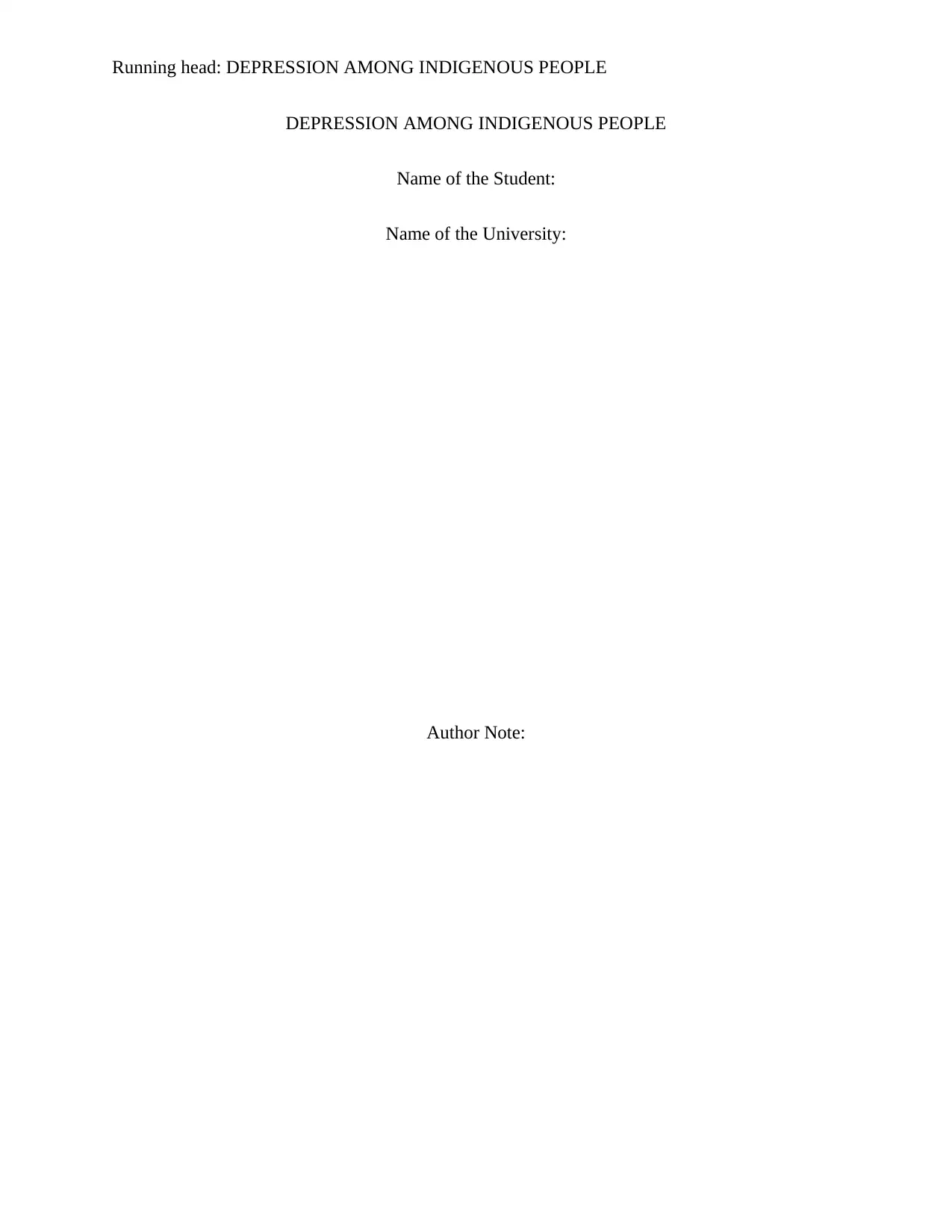
Running head: DEPRESSION AMONG INDIGENOUS PEOPLE
DEPRESSION AMONG INDIGENOUS PEOPLE
Name of the Student:
Name of the University:
Author Note:
DEPRESSION AMONG INDIGENOUS PEOPLE
Name of the Student:
Name of the University:
Author Note:
Paraphrase This Document
Need a fresh take? Get an instant paraphrase of this document with our AI Paraphraser
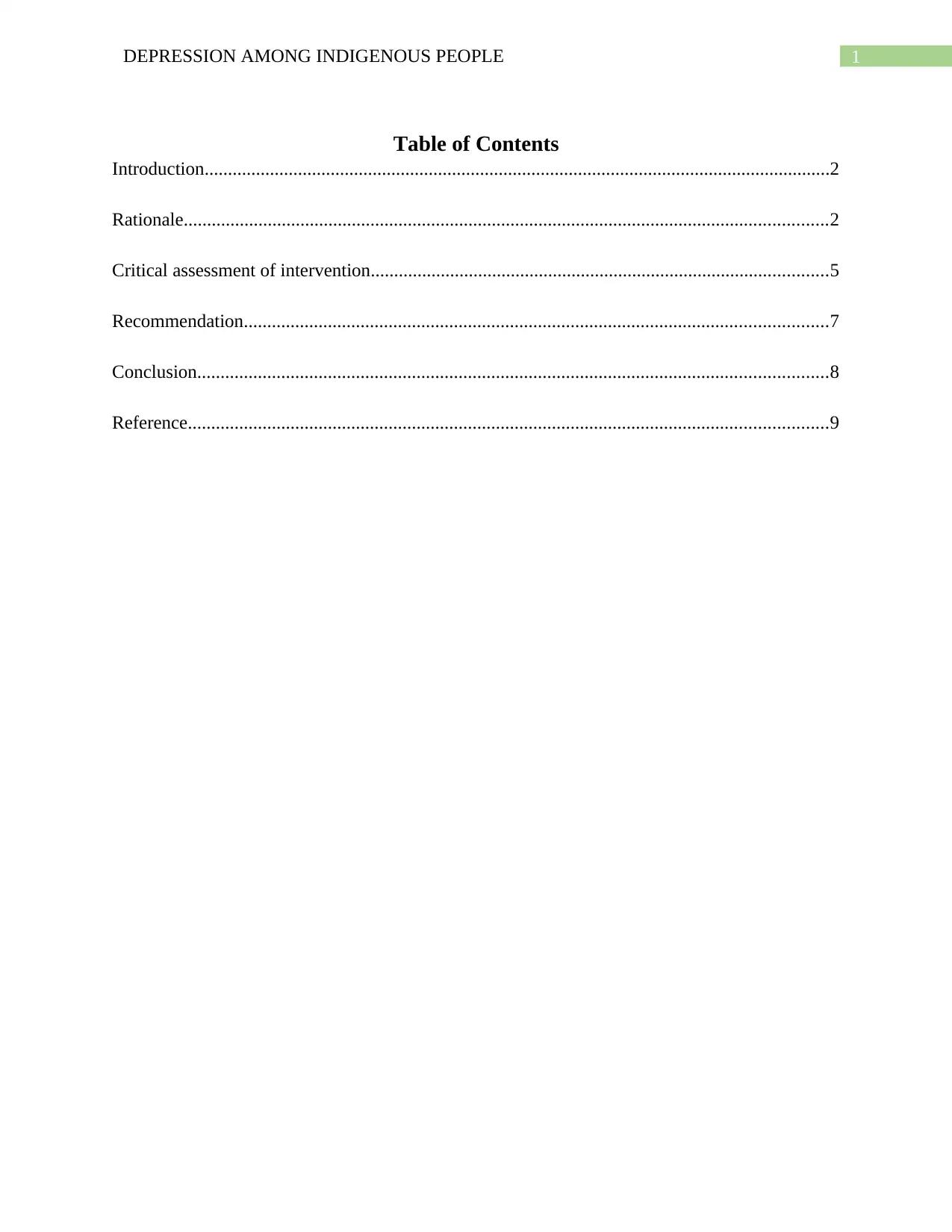
1DEPRESSION AMONG INDIGENOUS PEOPLE
Table of Contents
Introduction......................................................................................................................................2
Rationale..........................................................................................................................................2
Critical assessment of intervention..................................................................................................5
Recommendation.............................................................................................................................7
Conclusion.......................................................................................................................................8
Reference.........................................................................................................................................9
Table of Contents
Introduction......................................................................................................................................2
Rationale..........................................................................................................................................2
Critical assessment of intervention..................................................................................................5
Recommendation.............................................................................................................................7
Conclusion.......................................................................................................................................8
Reference.........................................................................................................................................9
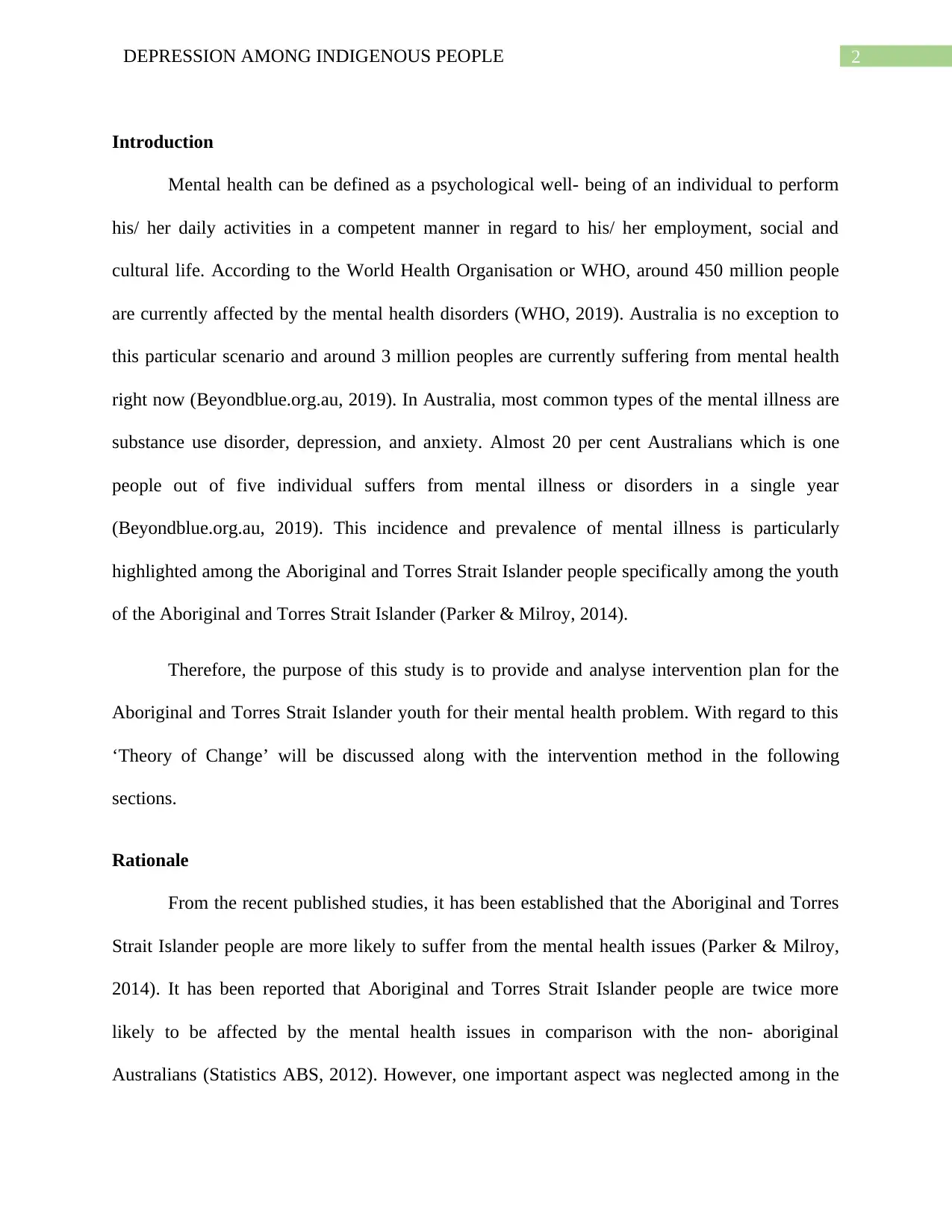
2DEPRESSION AMONG INDIGENOUS PEOPLE
Introduction
Mental health can be defined as a psychological well- being of an individual to perform
his/ her daily activities in a competent manner in regard to his/ her employment, social and
cultural life. According to the World Health Organisation or WHO, around 450 million people
are currently affected by the mental health disorders (WHO, 2019). Australia is no exception to
this particular scenario and around 3 million peoples are currently suffering from mental health
right now (Beyondblue.org.au, 2019). In Australia, most common types of the mental illness are
substance use disorder, depression, and anxiety. Almost 20 per cent Australians which is one
people out of five individual suffers from mental illness or disorders in a single year
(Beyondblue.org.au, 2019). This incidence and prevalence of mental illness is particularly
highlighted among the Aboriginal and Torres Strait Islander people specifically among the youth
of the Aboriginal and Torres Strait Islander (Parker & Milroy, 2014).
Therefore, the purpose of this study is to provide and analyse intervention plan for the
Aboriginal and Torres Strait Islander youth for their mental health problem. With regard to this
‘Theory of Change’ will be discussed along with the intervention method in the following
sections.
Rationale
From the recent published studies, it has been established that the Aboriginal and Torres
Strait Islander people are more likely to suffer from the mental health issues (Parker & Milroy,
2014). It has been reported that Aboriginal and Torres Strait Islander people are twice more
likely to be affected by the mental health issues in comparison with the non- aboriginal
Australians (Statistics ABS, 2012). However, one important aspect was neglected among in the
Introduction
Mental health can be defined as a psychological well- being of an individual to perform
his/ her daily activities in a competent manner in regard to his/ her employment, social and
cultural life. According to the World Health Organisation or WHO, around 450 million people
are currently affected by the mental health disorders (WHO, 2019). Australia is no exception to
this particular scenario and around 3 million peoples are currently suffering from mental health
right now (Beyondblue.org.au, 2019). In Australia, most common types of the mental illness are
substance use disorder, depression, and anxiety. Almost 20 per cent Australians which is one
people out of five individual suffers from mental illness or disorders in a single year
(Beyondblue.org.au, 2019). This incidence and prevalence of mental illness is particularly
highlighted among the Aboriginal and Torres Strait Islander people specifically among the youth
of the Aboriginal and Torres Strait Islander (Parker & Milroy, 2014).
Therefore, the purpose of this study is to provide and analyse intervention plan for the
Aboriginal and Torres Strait Islander youth for their mental health problem. With regard to this
‘Theory of Change’ will be discussed along with the intervention method in the following
sections.
Rationale
From the recent published studies, it has been established that the Aboriginal and Torres
Strait Islander people are more likely to suffer from the mental health issues (Parker & Milroy,
2014). It has been reported that Aboriginal and Torres Strait Islander people are twice more
likely to be affected by the mental health issues in comparison with the non- aboriginal
Australians (Statistics ABS, 2012). However, one important aspect was neglected among in the
⊘ This is a preview!⊘
Do you want full access?
Subscribe today to unlock all pages.

Trusted by 1+ million students worldwide
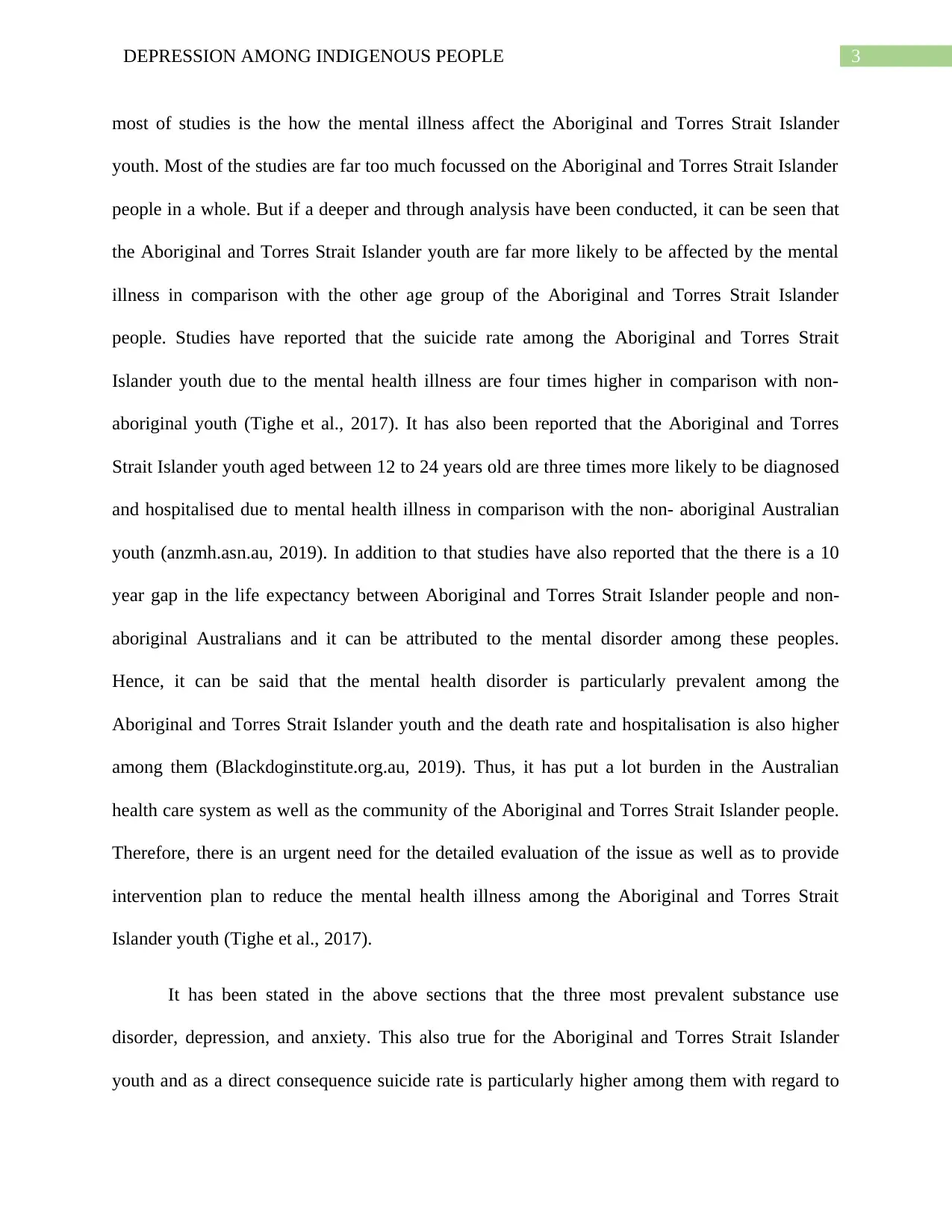
3DEPRESSION AMONG INDIGENOUS PEOPLE
most of studies is the how the mental illness affect the Aboriginal and Torres Strait Islander
youth. Most of the studies are far too much focussed on the Aboriginal and Torres Strait Islander
people in a whole. But if a deeper and through analysis have been conducted, it can be seen that
the Aboriginal and Torres Strait Islander youth are far more likely to be affected by the mental
illness in comparison with the other age group of the Aboriginal and Torres Strait Islander
people. Studies have reported that the suicide rate among the Aboriginal and Torres Strait
Islander youth due to the mental health illness are four times higher in comparison with non-
aboriginal youth (Tighe et al., 2017). It has also been reported that the Aboriginal and Torres
Strait Islander youth aged between 12 to 24 years old are three times more likely to be diagnosed
and hospitalised due to mental health illness in comparison with the non- aboriginal Australian
youth (anzmh.asn.au, 2019). In addition to that studies have also reported that the there is a 10
year gap in the life expectancy between Aboriginal and Torres Strait Islander people and non-
aboriginal Australians and it can be attributed to the mental disorder among these peoples.
Hence, it can be said that the mental health disorder is particularly prevalent among the
Aboriginal and Torres Strait Islander youth and the death rate and hospitalisation is also higher
among them (Blackdoginstitute.org.au, 2019). Thus, it has put a lot burden in the Australian
health care system as well as the community of the Aboriginal and Torres Strait Islander people.
Therefore, there is an urgent need for the detailed evaluation of the issue as well as to provide
intervention plan to reduce the mental health illness among the Aboriginal and Torres Strait
Islander youth (Tighe et al., 2017).
It has been stated in the above sections that the three most prevalent substance use
disorder, depression, and anxiety. This also true for the Aboriginal and Torres Strait Islander
youth and as a direct consequence suicide rate is particularly higher among them with regard to
most of studies is the how the mental illness affect the Aboriginal and Torres Strait Islander
youth. Most of the studies are far too much focussed on the Aboriginal and Torres Strait Islander
people in a whole. But if a deeper and through analysis have been conducted, it can be seen that
the Aboriginal and Torres Strait Islander youth are far more likely to be affected by the mental
illness in comparison with the other age group of the Aboriginal and Torres Strait Islander
people. Studies have reported that the suicide rate among the Aboriginal and Torres Strait
Islander youth due to the mental health illness are four times higher in comparison with non-
aboriginal youth (Tighe et al., 2017). It has also been reported that the Aboriginal and Torres
Strait Islander youth aged between 12 to 24 years old are three times more likely to be diagnosed
and hospitalised due to mental health illness in comparison with the non- aboriginal Australian
youth (anzmh.asn.au, 2019). In addition to that studies have also reported that the there is a 10
year gap in the life expectancy between Aboriginal and Torres Strait Islander people and non-
aboriginal Australians and it can be attributed to the mental disorder among these peoples.
Hence, it can be said that the mental health disorder is particularly prevalent among the
Aboriginal and Torres Strait Islander youth and the death rate and hospitalisation is also higher
among them (Blackdoginstitute.org.au, 2019). Thus, it has put a lot burden in the Australian
health care system as well as the community of the Aboriginal and Torres Strait Islander people.
Therefore, there is an urgent need for the detailed evaluation of the issue as well as to provide
intervention plan to reduce the mental health illness among the Aboriginal and Torres Strait
Islander youth (Tighe et al., 2017).
It has been stated in the above sections that the three most prevalent substance use
disorder, depression, and anxiety. This also true for the Aboriginal and Torres Strait Islander
youth and as a direct consequence suicide rate is particularly higher among them with regard to
Paraphrase This Document
Need a fresh take? Get an instant paraphrase of this document with our AI Paraphraser
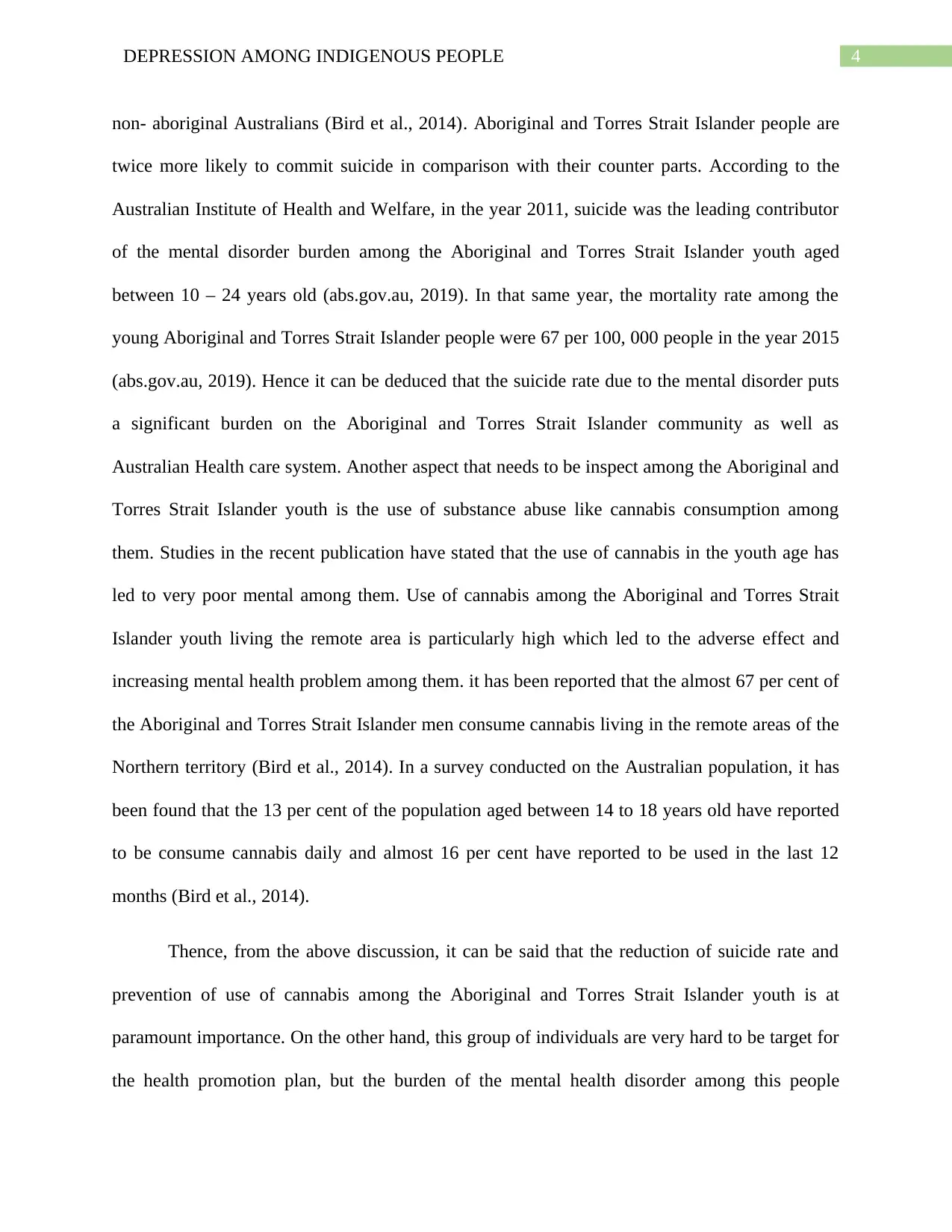
4DEPRESSION AMONG INDIGENOUS PEOPLE
non- aboriginal Australians (Bird et al., 2014). Aboriginal and Torres Strait Islander people are
twice more likely to commit suicide in comparison with their counter parts. According to the
Australian Institute of Health and Welfare, in the year 2011, suicide was the leading contributor
of the mental disorder burden among the Aboriginal and Torres Strait Islander youth aged
between 10 – 24 years old (abs.gov.au, 2019). In that same year, the mortality rate among the
young Aboriginal and Torres Strait Islander people were 67 per 100, 000 people in the year 2015
(abs.gov.au, 2019). Hence it can be deduced that the suicide rate due to the mental disorder puts
a significant burden on the Aboriginal and Torres Strait Islander community as well as
Australian Health care system. Another aspect that needs to be inspect among the Aboriginal and
Torres Strait Islander youth is the use of substance abuse like cannabis consumption among
them. Studies in the recent publication have stated that the use of cannabis in the youth age has
led to very poor mental among them. Use of cannabis among the Aboriginal and Torres Strait
Islander youth living the remote area is particularly high which led to the adverse effect and
increasing mental health problem among them. it has been reported that the almost 67 per cent of
the Aboriginal and Torres Strait Islander men consume cannabis living in the remote areas of the
Northern territory (Bird et al., 2014). In a survey conducted on the Australian population, it has
been found that the 13 per cent of the population aged between 14 to 18 years old have reported
to be consume cannabis daily and almost 16 per cent have reported to be used in the last 12
months (Bird et al., 2014).
Thence, from the above discussion, it can be said that the reduction of suicide rate and
prevention of use of cannabis among the Aboriginal and Torres Strait Islander youth is at
paramount importance. On the other hand, this group of individuals are very hard to be target for
the health promotion plan, but the burden of the mental health disorder among this people
non- aboriginal Australians (Bird et al., 2014). Aboriginal and Torres Strait Islander people are
twice more likely to commit suicide in comparison with their counter parts. According to the
Australian Institute of Health and Welfare, in the year 2011, suicide was the leading contributor
of the mental disorder burden among the Aboriginal and Torres Strait Islander youth aged
between 10 – 24 years old (abs.gov.au, 2019). In that same year, the mortality rate among the
young Aboriginal and Torres Strait Islander people were 67 per 100, 000 people in the year 2015
(abs.gov.au, 2019). Hence it can be deduced that the suicide rate due to the mental disorder puts
a significant burden on the Aboriginal and Torres Strait Islander community as well as
Australian Health care system. Another aspect that needs to be inspect among the Aboriginal and
Torres Strait Islander youth is the use of substance abuse like cannabis consumption among
them. Studies in the recent publication have stated that the use of cannabis in the youth age has
led to very poor mental among them. Use of cannabis among the Aboriginal and Torres Strait
Islander youth living the remote area is particularly high which led to the adverse effect and
increasing mental health problem among them. it has been reported that the almost 67 per cent of
the Aboriginal and Torres Strait Islander men consume cannabis living in the remote areas of the
Northern territory (Bird et al., 2014). In a survey conducted on the Australian population, it has
been found that the 13 per cent of the population aged between 14 to 18 years old have reported
to be consume cannabis daily and almost 16 per cent have reported to be used in the last 12
months (Bird et al., 2014).
Thence, from the above discussion, it can be said that the reduction of suicide rate and
prevention of use of cannabis among the Aboriginal and Torres Strait Islander youth is at
paramount importance. On the other hand, this group of individuals are very hard to be target for
the health promotion plan, but the burden of the mental health disorder among this people
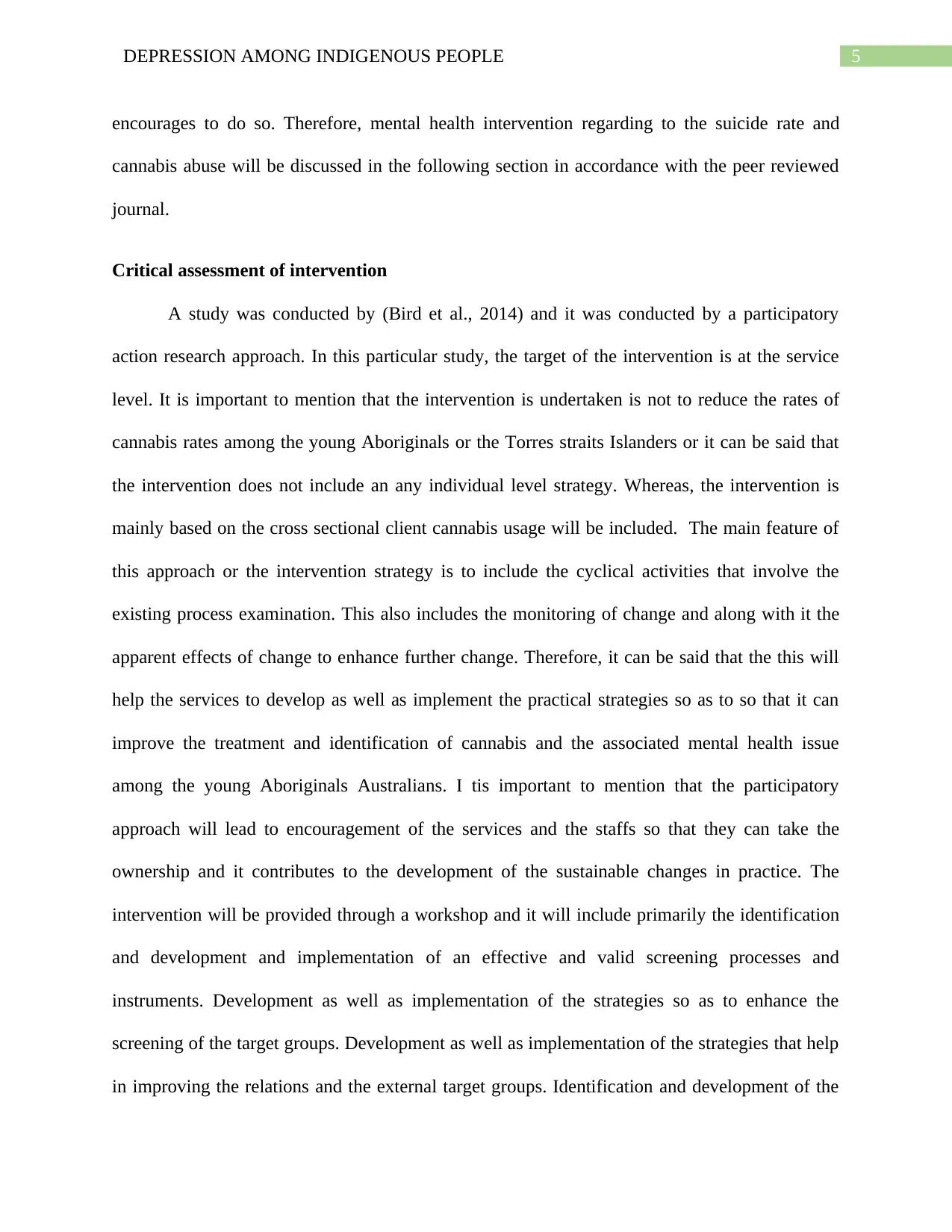
5DEPRESSION AMONG INDIGENOUS PEOPLE
encourages to do so. Therefore, mental health intervention regarding to the suicide rate and
cannabis abuse will be discussed in the following section in accordance with the peer reviewed
journal.
Critical assessment of intervention
A study was conducted by (Bird et al., 2014) and it was conducted by a participatory
action research approach. In this particular study, the target of the intervention is at the service
level. It is important to mention that the intervention is undertaken is not to reduce the rates of
cannabis rates among the young Aboriginals or the Torres straits Islanders or it can be said that
the intervention does not include an any individual level strategy. Whereas, the intervention is
mainly based on the cross sectional client cannabis usage will be included. The main feature of
this approach or the intervention strategy is to include the cyclical activities that involve the
existing process examination. This also includes the monitoring of change and along with it the
apparent effects of change to enhance further change. Therefore, it can be said that the this will
help the services to develop as well as implement the practical strategies so as to so that it can
improve the treatment and identification of cannabis and the associated mental health issue
among the young Aboriginals Australians. I tis important to mention that the participatory
approach will lead to encouragement of the services and the staffs so that they can take the
ownership and it contributes to the development of the sustainable changes in practice. The
intervention will be provided through a workshop and it will include primarily the identification
and development and implementation of an effective and valid screening processes and
instruments. Development as well as implementation of the strategies so as to enhance the
screening of the target groups. Development as well as implementation of the strategies that help
in improving the relations and the external target groups. Identification and development of the
encourages to do so. Therefore, mental health intervention regarding to the suicide rate and
cannabis abuse will be discussed in the following section in accordance with the peer reviewed
journal.
Critical assessment of intervention
A study was conducted by (Bird et al., 2014) and it was conducted by a participatory
action research approach. In this particular study, the target of the intervention is at the service
level. It is important to mention that the intervention is undertaken is not to reduce the rates of
cannabis rates among the young Aboriginals or the Torres straits Islanders or it can be said that
the intervention does not include an any individual level strategy. Whereas, the intervention is
mainly based on the cross sectional client cannabis usage will be included. The main feature of
this approach or the intervention strategy is to include the cyclical activities that involve the
existing process examination. This also includes the monitoring of change and along with it the
apparent effects of change to enhance further change. Therefore, it can be said that the this will
help the services to develop as well as implement the practical strategies so as to so that it can
improve the treatment and identification of cannabis and the associated mental health issue
among the young Aboriginals Australians. I tis important to mention that the participatory
approach will lead to encouragement of the services and the staffs so that they can take the
ownership and it contributes to the development of the sustainable changes in practice. The
intervention will be provided through a workshop and it will include primarily the identification
and development and implementation of an effective and valid screening processes and
instruments. Development as well as implementation of the strategies so as to enhance the
screening of the target groups. Development as well as implementation of the strategies that help
in improving the relations and the external target groups. Identification and development of the
⊘ This is a preview!⊘
Do you want full access?
Subscribe today to unlock all pages.

Trusted by 1+ million students worldwide
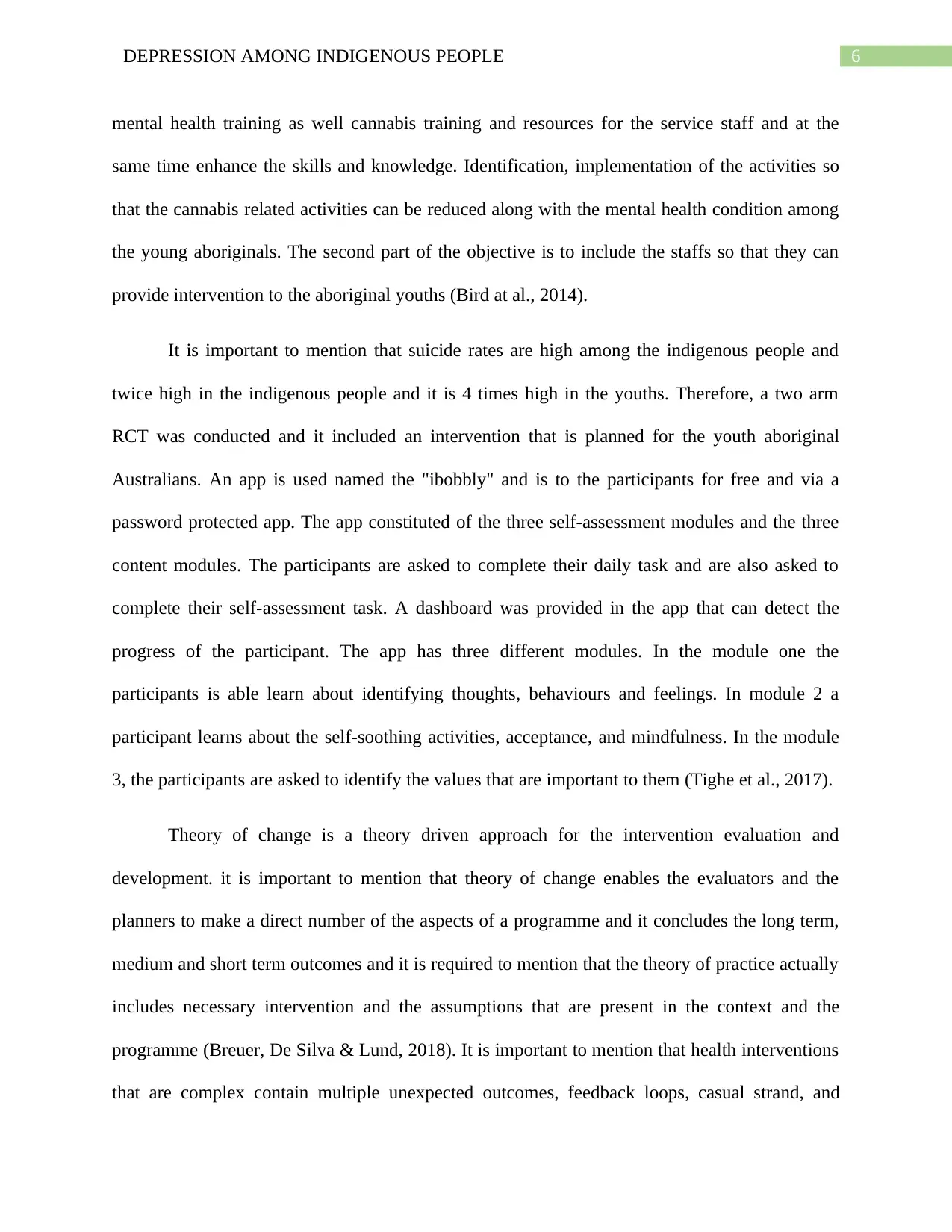
6DEPRESSION AMONG INDIGENOUS PEOPLE
mental health training as well cannabis training and resources for the service staff and at the
same time enhance the skills and knowledge. Identification, implementation of the activities so
that the cannabis related activities can be reduced along with the mental health condition among
the young aboriginals. The second part of the objective is to include the staffs so that they can
provide intervention to the aboriginal youths (Bird at al., 2014).
It is important to mention that suicide rates are high among the indigenous people and
twice high in the indigenous people and it is 4 times high in the youths. Therefore, a two arm
RCT was conducted and it included an intervention that is planned for the youth aboriginal
Australians. An app is used named the "ibobbly" and is to the participants for free and via a
password protected app. The app constituted of the three self-assessment modules and the three
content modules. The participants are asked to complete their daily task and are also asked to
complete their self-assessment task. A dashboard was provided in the app that can detect the
progress of the participant. The app has three different modules. In the module one the
participants is able learn about identifying thoughts, behaviours and feelings. In module 2 a
participant learns about the self-soothing activities, acceptance, and mindfulness. In the module
3, the participants are asked to identify the values that are important to them (Tighe et al., 2017).
Theory of change is a theory driven approach for the intervention evaluation and
development. it is important to mention that theory of change enables the evaluators and the
planners to make a direct number of the aspects of a programme and it concludes the long term,
medium and short term outcomes and it is required to mention that the theory of practice actually
includes necessary intervention and the assumptions that are present in the context and the
programme (Breuer, De Silva & Lund, 2018). It is important to mention that health interventions
that are complex contain multiple unexpected outcomes, feedback loops, casual strand, and
mental health training as well cannabis training and resources for the service staff and at the
same time enhance the skills and knowledge. Identification, implementation of the activities so
that the cannabis related activities can be reduced along with the mental health condition among
the young aboriginals. The second part of the objective is to include the staffs so that they can
provide intervention to the aboriginal youths (Bird at al., 2014).
It is important to mention that suicide rates are high among the indigenous people and
twice high in the indigenous people and it is 4 times high in the youths. Therefore, a two arm
RCT was conducted and it included an intervention that is planned for the youth aboriginal
Australians. An app is used named the "ibobbly" and is to the participants for free and via a
password protected app. The app constituted of the three self-assessment modules and the three
content modules. The participants are asked to complete their daily task and are also asked to
complete their self-assessment task. A dashboard was provided in the app that can detect the
progress of the participant. The app has three different modules. In the module one the
participants is able learn about identifying thoughts, behaviours and feelings. In module 2 a
participant learns about the self-soothing activities, acceptance, and mindfulness. In the module
3, the participants are asked to identify the values that are important to them (Tighe et al., 2017).
Theory of change is a theory driven approach for the intervention evaluation and
development. it is important to mention that theory of change enables the evaluators and the
planners to make a direct number of the aspects of a programme and it concludes the long term,
medium and short term outcomes and it is required to mention that the theory of practice actually
includes necessary intervention and the assumptions that are present in the context and the
programme (Breuer, De Silva & Lund, 2018). It is important to mention that health interventions
that are complex contain multiple unexpected outcomes, feedback loops, casual strand, and
Paraphrase This Document
Need a fresh take? Get an instant paraphrase of this document with our AI Paraphraser
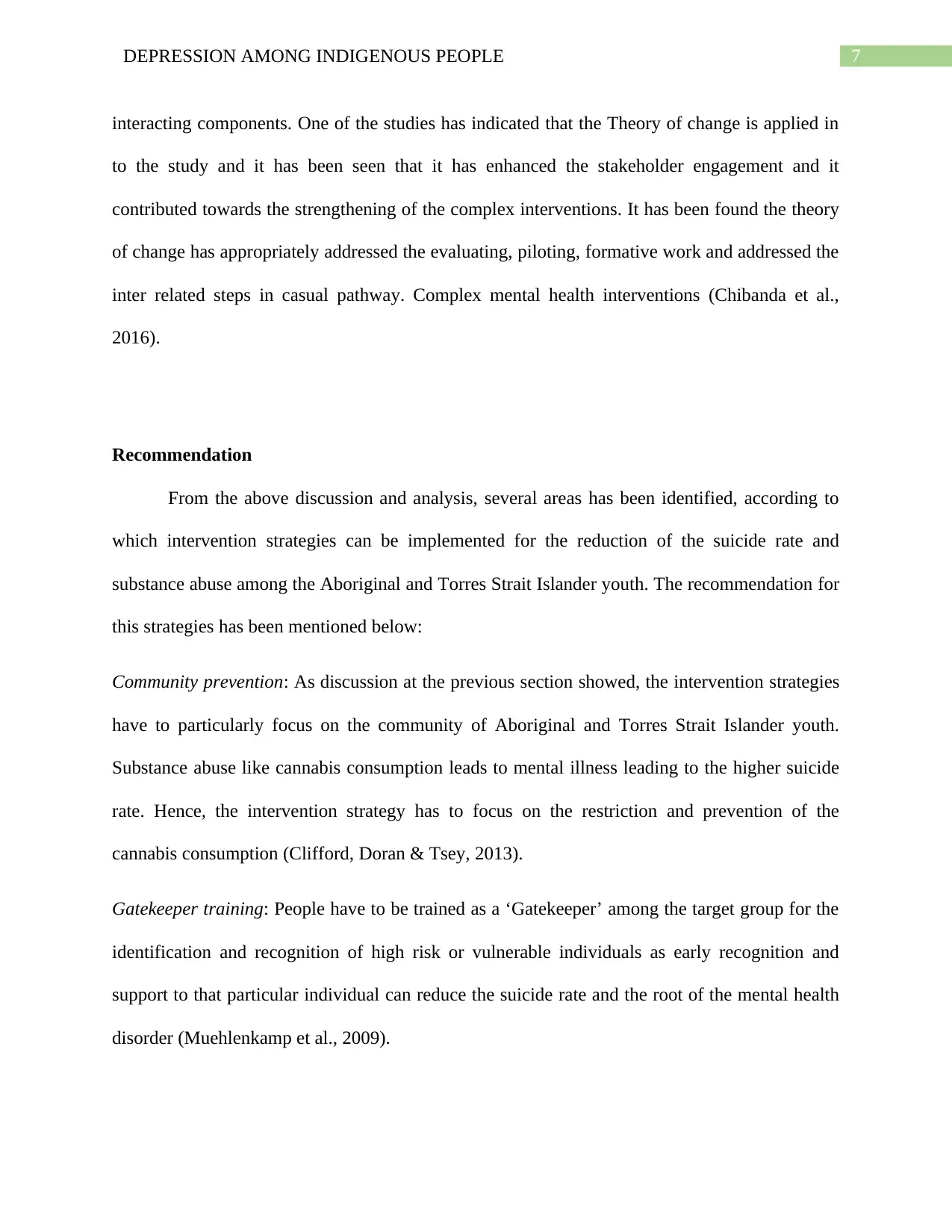
7DEPRESSION AMONG INDIGENOUS PEOPLE
interacting components. One of the studies has indicated that the Theory of change is applied in
to the study and it has been seen that it has enhanced the stakeholder engagement and it
contributed towards the strengthening of the complex interventions. It has been found the theory
of change has appropriately addressed the evaluating, piloting, formative work and addressed the
inter related steps in casual pathway. Complex mental health interventions (Chibanda et al.,
2016).
Recommendation
From the above discussion and analysis, several areas has been identified, according to
which intervention strategies can be implemented for the reduction of the suicide rate and
substance abuse among the Aboriginal and Torres Strait Islander youth. The recommendation for
this strategies has been mentioned below:
Community prevention: As discussion at the previous section showed, the intervention strategies
have to particularly focus on the community of Aboriginal and Torres Strait Islander youth.
Substance abuse like cannabis consumption leads to mental illness leading to the higher suicide
rate. Hence, the intervention strategy has to focus on the restriction and prevention of the
cannabis consumption (Clifford, Doran & Tsey, 2013).
Gatekeeper training: People have to be trained as a ‘Gatekeeper’ among the target group for the
identification and recognition of high risk or vulnerable individuals as early recognition and
support to that particular individual can reduce the suicide rate and the root of the mental health
disorder (Muehlenkamp et al., 2009).
interacting components. One of the studies has indicated that the Theory of change is applied in
to the study and it has been seen that it has enhanced the stakeholder engagement and it
contributed towards the strengthening of the complex interventions. It has been found the theory
of change has appropriately addressed the evaluating, piloting, formative work and addressed the
inter related steps in casual pathway. Complex mental health interventions (Chibanda et al.,
2016).
Recommendation
From the above discussion and analysis, several areas has been identified, according to
which intervention strategies can be implemented for the reduction of the suicide rate and
substance abuse among the Aboriginal and Torres Strait Islander youth. The recommendation for
this strategies has been mentioned below:
Community prevention: As discussion at the previous section showed, the intervention strategies
have to particularly focus on the community of Aboriginal and Torres Strait Islander youth.
Substance abuse like cannabis consumption leads to mental illness leading to the higher suicide
rate. Hence, the intervention strategy has to focus on the restriction and prevention of the
cannabis consumption (Clifford, Doran & Tsey, 2013).
Gatekeeper training: People have to be trained as a ‘Gatekeeper’ among the target group for the
identification and recognition of high risk or vulnerable individuals as early recognition and
support to that particular individual can reduce the suicide rate and the root of the mental health
disorder (Muehlenkamp et al., 2009).
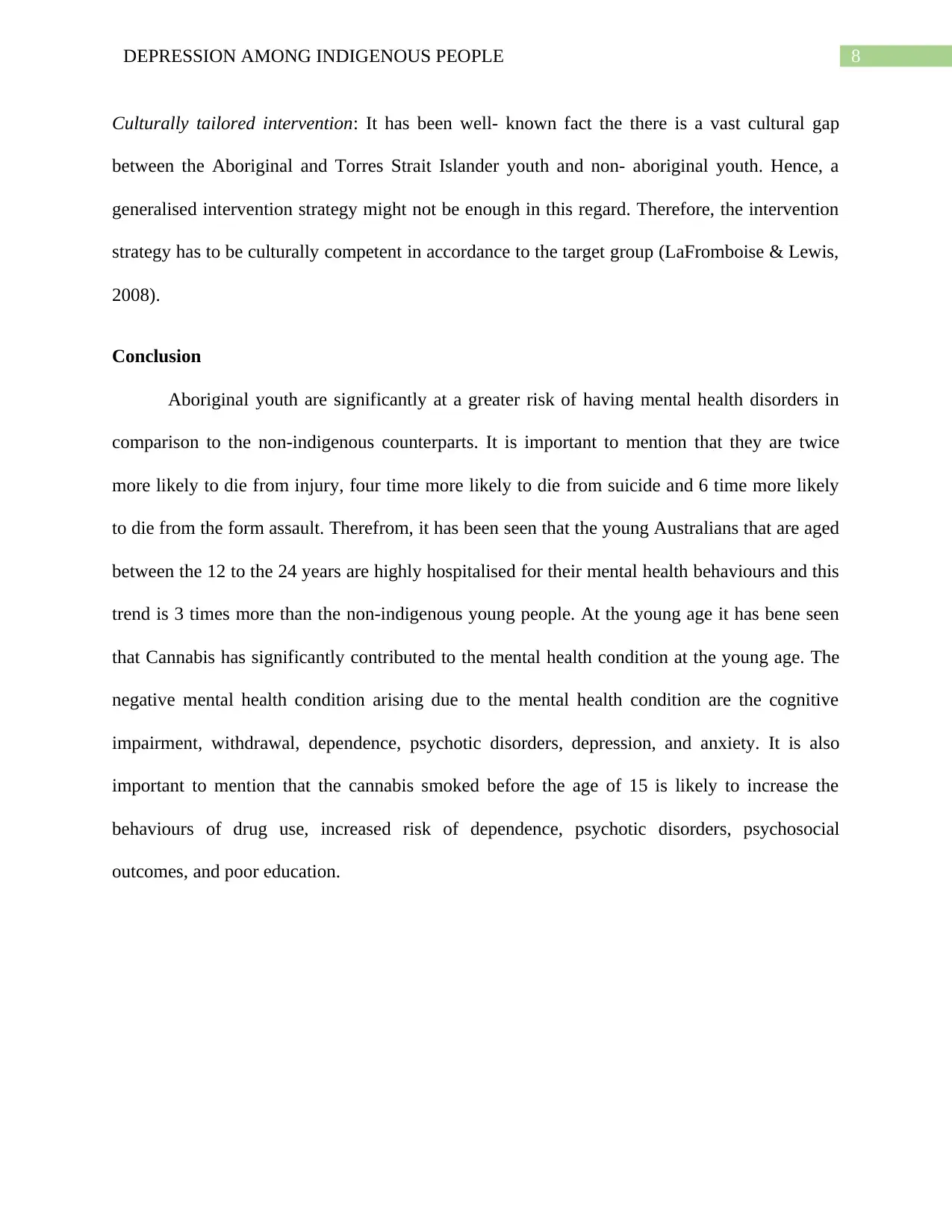
8DEPRESSION AMONG INDIGENOUS PEOPLE
Culturally tailored intervention: It has been well- known fact the there is a vast cultural gap
between the Aboriginal and Torres Strait Islander youth and non- aboriginal youth. Hence, a
generalised intervention strategy might not be enough in this regard. Therefore, the intervention
strategy has to be culturally competent in accordance to the target group (LaFromboise & Lewis,
2008).
Conclusion
Aboriginal youth are significantly at a greater risk of having mental health disorders in
comparison to the non-indigenous counterparts. It is important to mention that they are twice
more likely to die from injury, four time more likely to die from suicide and 6 time more likely
to die from the form assault. Therefrom, it has been seen that the young Australians that are aged
between the 12 to the 24 years are highly hospitalised for their mental health behaviours and this
trend is 3 times more than the non-indigenous young people. At the young age it has bene seen
that Cannabis has significantly contributed to the mental health condition at the young age. The
negative mental health condition arising due to the mental health condition are the cognitive
impairment, withdrawal, dependence, psychotic disorders, depression, and anxiety. It is also
important to mention that the cannabis smoked before the age of 15 is likely to increase the
behaviours of drug use, increased risk of dependence, psychotic disorders, psychosocial
outcomes, and poor education.
Culturally tailored intervention: It has been well- known fact the there is a vast cultural gap
between the Aboriginal and Torres Strait Islander youth and non- aboriginal youth. Hence, a
generalised intervention strategy might not be enough in this regard. Therefore, the intervention
strategy has to be culturally competent in accordance to the target group (LaFromboise & Lewis,
2008).
Conclusion
Aboriginal youth are significantly at a greater risk of having mental health disorders in
comparison to the non-indigenous counterparts. It is important to mention that they are twice
more likely to die from injury, four time more likely to die from suicide and 6 time more likely
to die from the form assault. Therefrom, it has been seen that the young Australians that are aged
between the 12 to the 24 years are highly hospitalised for their mental health behaviours and this
trend is 3 times more than the non-indigenous young people. At the young age it has bene seen
that Cannabis has significantly contributed to the mental health condition at the young age. The
negative mental health condition arising due to the mental health condition are the cognitive
impairment, withdrawal, dependence, psychotic disorders, depression, and anxiety. It is also
important to mention that the cannabis smoked before the age of 15 is likely to increase the
behaviours of drug use, increased risk of dependence, psychotic disorders, psychosocial
outcomes, and poor education.
⊘ This is a preview!⊘
Do you want full access?
Subscribe today to unlock all pages.

Trusted by 1+ million students worldwide
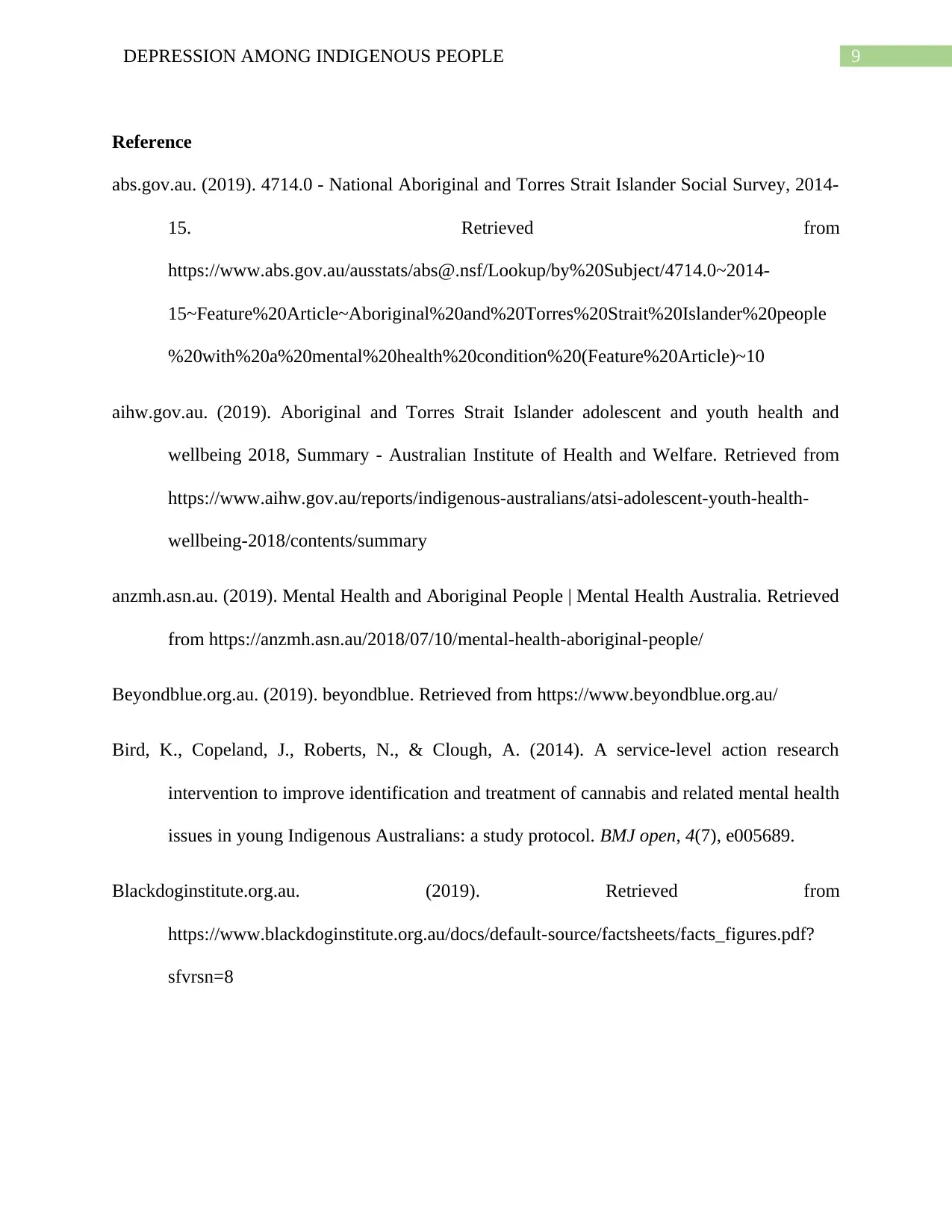
9DEPRESSION AMONG INDIGENOUS PEOPLE
Reference
abs.gov.au. (2019). 4714.0 - National Aboriginal and Torres Strait Islander Social Survey, 2014-
15. Retrieved from
https://www.abs.gov.au/ausstats/abs@.nsf/Lookup/by%20Subject/4714.0~2014-
15~Feature%20Article~Aboriginal%20and%20Torres%20Strait%20Islander%20people
%20with%20a%20mental%20health%20condition%20(Feature%20Article)~10
aihw.gov.au. (2019). Aboriginal and Torres Strait Islander adolescent and youth health and
wellbeing 2018, Summary - Australian Institute of Health and Welfare. Retrieved from
https://www.aihw.gov.au/reports/indigenous-australians/atsi-adolescent-youth-health-
wellbeing-2018/contents/summary
anzmh.asn.au. (2019). Mental Health and Aboriginal People | Mental Health Australia. Retrieved
from https://anzmh.asn.au/2018/07/10/mental-health-aboriginal-people/
Beyondblue.org.au. (2019). beyondblue. Retrieved from https://www.beyondblue.org.au/
Bird, K., Copeland, J., Roberts, N., & Clough, A. (2014). A service-level action research
intervention to improve identification and treatment of cannabis and related mental health
issues in young Indigenous Australians: a study protocol. BMJ open, 4(7), e005689.
Blackdoginstitute.org.au. (2019). Retrieved from
https://www.blackdoginstitute.org.au/docs/default-source/factsheets/facts_figures.pdf?
sfvrsn=8
Reference
abs.gov.au. (2019). 4714.0 - National Aboriginal and Torres Strait Islander Social Survey, 2014-
15. Retrieved from
https://www.abs.gov.au/ausstats/abs@.nsf/Lookup/by%20Subject/4714.0~2014-
15~Feature%20Article~Aboriginal%20and%20Torres%20Strait%20Islander%20people
%20with%20a%20mental%20health%20condition%20(Feature%20Article)~10
aihw.gov.au. (2019). Aboriginal and Torres Strait Islander adolescent and youth health and
wellbeing 2018, Summary - Australian Institute of Health and Welfare. Retrieved from
https://www.aihw.gov.au/reports/indigenous-australians/atsi-adolescent-youth-health-
wellbeing-2018/contents/summary
anzmh.asn.au. (2019). Mental Health and Aboriginal People | Mental Health Australia. Retrieved
from https://anzmh.asn.au/2018/07/10/mental-health-aboriginal-people/
Beyondblue.org.au. (2019). beyondblue. Retrieved from https://www.beyondblue.org.au/
Bird, K., Copeland, J., Roberts, N., & Clough, A. (2014). A service-level action research
intervention to improve identification and treatment of cannabis and related mental health
issues in young Indigenous Australians: a study protocol. BMJ open, 4(7), e005689.
Blackdoginstitute.org.au. (2019). Retrieved from
https://www.blackdoginstitute.org.au/docs/default-source/factsheets/facts_figures.pdf?
sfvrsn=8
Paraphrase This Document
Need a fresh take? Get an instant paraphrase of this document with our AI Paraphraser
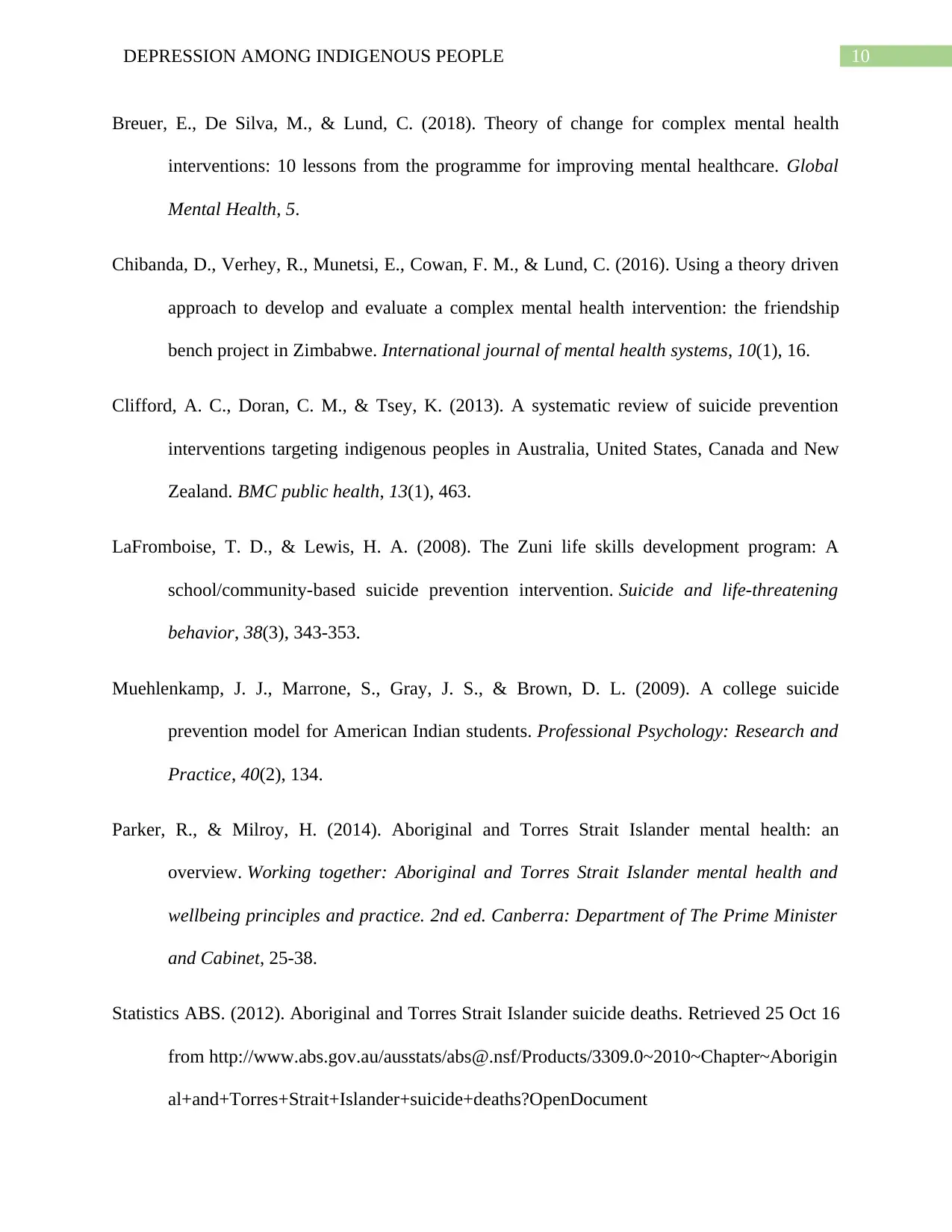
10DEPRESSION AMONG INDIGENOUS PEOPLE
Breuer, E., De Silva, M., & Lund, C. (2018). Theory of change for complex mental health
interventions: 10 lessons from the programme for improving mental healthcare. Global
Mental Health, 5.
Chibanda, D., Verhey, R., Munetsi, E., Cowan, F. M., & Lund, C. (2016). Using a theory driven
approach to develop and evaluate a complex mental health intervention: the friendship
bench project in Zimbabwe. International journal of mental health systems, 10(1), 16.
Clifford, A. C., Doran, C. M., & Tsey, K. (2013). A systematic review of suicide prevention
interventions targeting indigenous peoples in Australia, United States, Canada and New
Zealand. BMC public health, 13(1), 463.
LaFromboise, T. D., & Lewis, H. A. (2008). The Zuni life skills development program: A
school/community-based suicide prevention intervention. Suicide and life-threatening
behavior, 38(3), 343-353.
Muehlenkamp, J. J., Marrone, S., Gray, J. S., & Brown, D. L. (2009). A college suicide
prevention model for American Indian students. Professional Psychology: Research and
Practice, 40(2), 134.
Parker, R., & Milroy, H. (2014). Aboriginal and Torres Strait Islander mental health: an
overview. Working together: Aboriginal and Torres Strait Islander mental health and
wellbeing principles and practice. 2nd ed. Canberra: Department of The Prime Minister
and Cabinet, 25-38.
Statistics ABS. (2012). Aboriginal and Torres Strait Islander suicide deaths. Retrieved 25 Oct 16
from http://www.abs.gov.au/ausstats/abs@.nsf/Products/3309.0~2010~Chapter~Aborigin
al+and+Torres+Strait+Islander+suicide+deaths?OpenDocument
Breuer, E., De Silva, M., & Lund, C. (2018). Theory of change for complex mental health
interventions: 10 lessons from the programme for improving mental healthcare. Global
Mental Health, 5.
Chibanda, D., Verhey, R., Munetsi, E., Cowan, F. M., & Lund, C. (2016). Using a theory driven
approach to develop and evaluate a complex mental health intervention: the friendship
bench project in Zimbabwe. International journal of mental health systems, 10(1), 16.
Clifford, A. C., Doran, C. M., & Tsey, K. (2013). A systematic review of suicide prevention
interventions targeting indigenous peoples in Australia, United States, Canada and New
Zealand. BMC public health, 13(1), 463.
LaFromboise, T. D., & Lewis, H. A. (2008). The Zuni life skills development program: A
school/community-based suicide prevention intervention. Suicide and life-threatening
behavior, 38(3), 343-353.
Muehlenkamp, J. J., Marrone, S., Gray, J. S., & Brown, D. L. (2009). A college suicide
prevention model for American Indian students. Professional Psychology: Research and
Practice, 40(2), 134.
Parker, R., & Milroy, H. (2014). Aboriginal and Torres Strait Islander mental health: an
overview. Working together: Aboriginal and Torres Strait Islander mental health and
wellbeing principles and practice. 2nd ed. Canberra: Department of The Prime Minister
and Cabinet, 25-38.
Statistics ABS. (2012). Aboriginal and Torres Strait Islander suicide deaths. Retrieved 25 Oct 16
from http://www.abs.gov.au/ausstats/abs@.nsf/Products/3309.0~2010~Chapter~Aborigin
al+and+Torres+Strait+Islander+suicide+deaths?OpenDocument
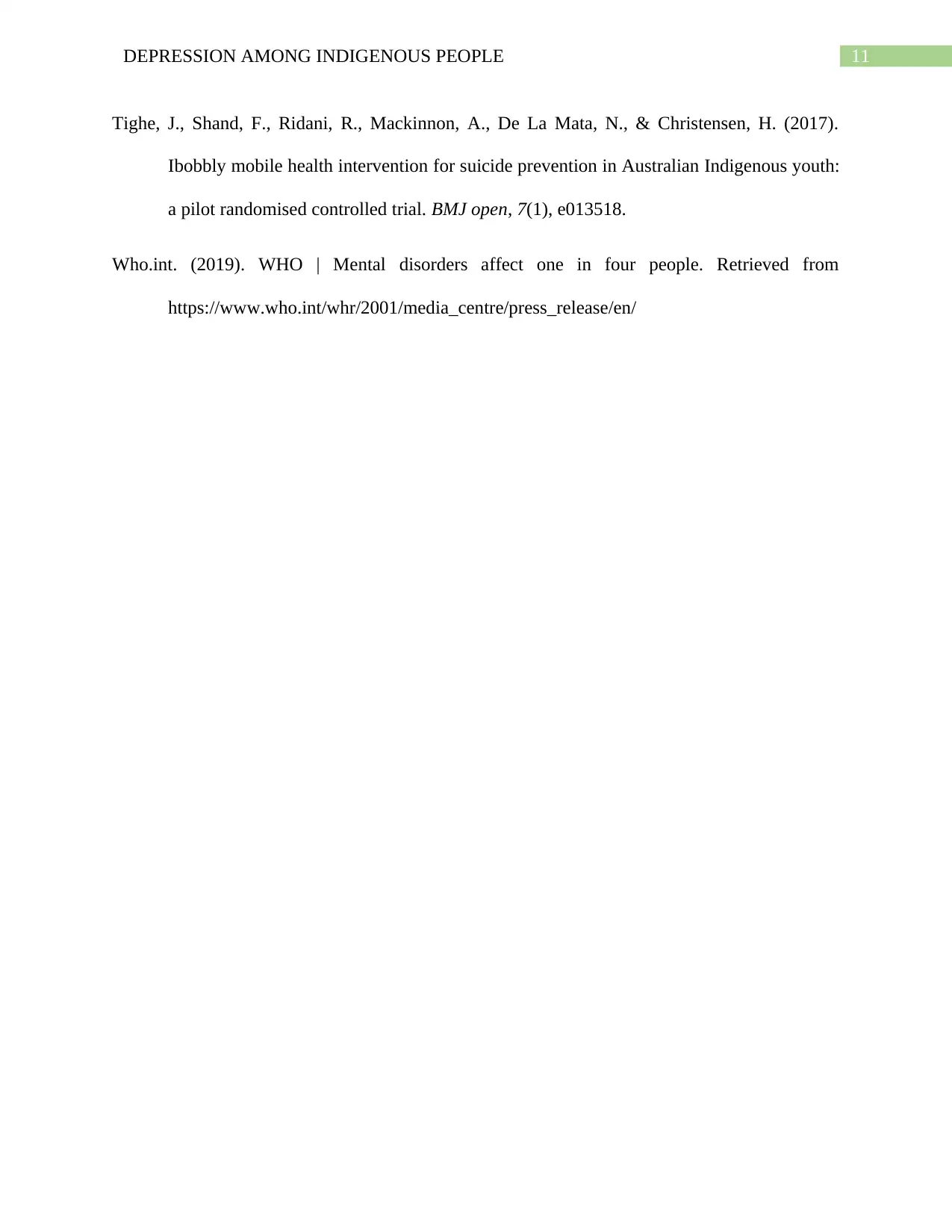
11DEPRESSION AMONG INDIGENOUS PEOPLE
Tighe, J., Shand, F., Ridani, R., Mackinnon, A., De La Mata, N., & Christensen, H. (2017).
Ibobbly mobile health intervention for suicide prevention in Australian Indigenous youth:
a pilot randomised controlled trial. BMJ open, 7(1), e013518.
Who.int. (2019). WHO | Mental disorders affect one in four people. Retrieved from
https://www.who.int/whr/2001/media_centre/press_release/en/
Tighe, J., Shand, F., Ridani, R., Mackinnon, A., De La Mata, N., & Christensen, H. (2017).
Ibobbly mobile health intervention for suicide prevention in Australian Indigenous youth:
a pilot randomised controlled trial. BMJ open, 7(1), e013518.
Who.int. (2019). WHO | Mental disorders affect one in four people. Retrieved from
https://www.who.int/whr/2001/media_centre/press_release/en/
⊘ This is a preview!⊘
Do you want full access?
Subscribe today to unlock all pages.

Trusted by 1+ million students worldwide
1 out of 12
Related Documents
Your All-in-One AI-Powered Toolkit for Academic Success.
+13062052269
info@desklib.com
Available 24*7 on WhatsApp / Email
![[object Object]](/_next/static/media/star-bottom.7253800d.svg)
Unlock your academic potential
Copyright © 2020–2025 A2Z Services. All Rights Reserved. Developed and managed by ZUCOL.




